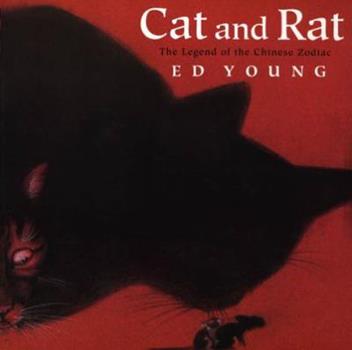Cat and Rat and The Cat’s Tale are both about the origin of the Chinese zodiac which was established in a race the Jade Emperor set up. I like the Ed Young version the best, because he is such a great illustrator and his story has more dialogue in it. On the other hand, The Cat’s Tale is in the first person which provides an opportunity to teach point of view.
Ed Young, ©2019, Macmillan Books, ISBN 9780805060492
Pourquoi Stories: How Things Came To Be
The literary name for the stories of how things originated is the French word for “Why” which is “Pourquoi”. This is an example, among several, of stories of how things originated. Students could write their own pourquoi story of how ordinary things in their environment came to be: stop lights, bananas, a park, etc.
Stereotypes of Animals
There are specific stereotypes that are basically agreed to from one culture to the other. A matching activity with qualities on one side and the name of the animal on the other will help reveal to students how widely we agree on these stereotypes. For example:
- Owls are …
- Pigs are …
- Oxen are …
- Mules are …
Fair
Here’s an important question in life: What is fair? Is this race fair? Is the Jade Emperor rigging it? What about the actual competing animals—should the Jade Emperor intervene? Is this a good way of deciding priority?
For more creative writing ideas, click Cat and Rat to download.


 The story of how 200 years ago, the daughter of Lord and Lady Byron, Ada Lovelace, wrote the first program—before there was electricity to make it work. Working with Thomas Babbage on the Analytical Engine, she wrote step-by-step how Bernoulli numbers could be coded for the machine.
The story of how 200 years ago, the daughter of Lord and Lady Byron, Ada Lovelace, wrote the first program—before there was electricity to make it work. Working with Thomas Babbage on the Analytical Engine, she wrote step-by-step how Bernoulli numbers could be coded for the machine. King Louis XIV ruled France (the superpower of its day) for 72 years. He had the biggest army, the biggest palace, the biggest parties and gifts, but, he was short. To compensate, he first commissions the highest throne, then the biggest wig, then the highest heels. Dancing in his new heels, he falls and is embarrassed.
King Louis XIV ruled France (the superpower of its day) for 72 years. He had the biggest army, the biggest palace, the biggest parties and gifts, but, he was short. To compensate, he first commissions the highest throne, then the biggest wig, then the highest heels. Dancing in his new heels, he falls and is embarrassed. The Cat tries to tell the Little Red Riding Hood story while the Dog, who loves superheroes, criticizes, adds his own thoughts, and questions the morality of the story. Lots of fun…very post-modern.
The Cat tries to tell the Little Red Riding Hood story while the Dog, who loves superheroes, criticizes, adds his own thoughts, and questions the morality of the story. Lots of fun…very post-modern. Mr. Mutt is the Ann Landers of dogs. Six dogs write in with their problems, and receive answers from Mr. Mutt, along with critiques from The Queen (a cat with a point of view. Answers are accompanied by cute graphs, useful for teaching graphing to students. It also closes with two newspaper articles as the cats attack Mr. Mutt.
Mr. Mutt is the Ann Landers of dogs. Six dogs write in with their problems, and receive answers from Mr. Mutt, along with critiques from The Queen (a cat with a point of view. Answers are accompanied by cute graphs, useful for teaching graphing to students. It also closes with two newspaper articles as the cats attack Mr. Mutt. The ant is invited to the lion’s dinner party and is shocked at the manners of the other guests as they greedily “share” the cake. When she herself is accused of being greedy, the ant turns the tables on the other guests.
The ant is invited to the lion’s dinner party and is shocked at the manners of the other guests as they greedily “share” the cake. When she herself is accused of being greedy, the ant turns the tables on the other guests.
 The biography of the ancient Greek mathematician and librarian who measured the circumference of the earth, with an error of only 200 miles, at a time when people didn’t even know for sure the earth was round, using math alone.
The biography of the ancient Greek mathematician and librarian who measured the circumference of the earth, with an error of only 200 miles, at a time when people didn’t even know for sure the earth was round, using math alone. This is a picture book version of Jerry Seinfeld’s wonderful routine on what Halloween was like to him as a child.
This is a picture book version of Jerry Seinfeld’s wonderful routine on what Halloween was like to him as a child. The Candy Vote
The Candy Vote Fibonacci was part of the revolutionary change from Roman numerals to Arabic numerals in the 12th century. His most important contribution to math is the Fibonacci sequence, which this book explains.
Fibonacci was part of the revolutionary change from Roman numerals to Arabic numerals in the 12th century. His most important contribution to math is the Fibonacci sequence, which this book explains. Astonishingly, nature uses these numbers all the time…in flower petals, seeds inside, starfish, 3 leaf clovers, 8 sections in a lemon, etc. Even humans have 1 head, 2 eyes, 5 fingers, etc.
Astonishingly, nature uses these numbers all the time…in flower petals, seeds inside, starfish, 3 leaf clovers, 8 sections in a lemon, etc. Even humans have 1 head, 2 eyes, 5 fingers, etc.